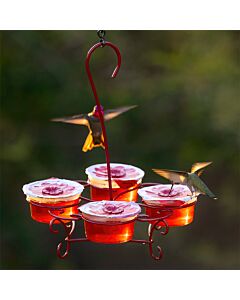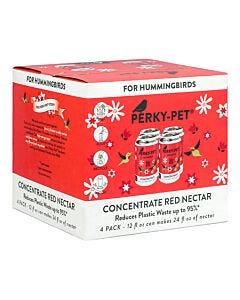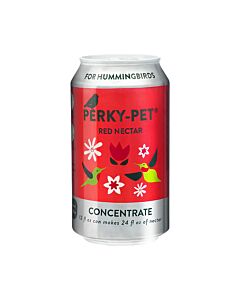Hummingbird Food Guide
A hummingbird’s diet must contain a variety of nutrients for the birds to remain healthy – nutrients such as protein, amino acids, vitamins and minerals. Because of their high-energy lifestyle, hummingbirds must constantly seek and find dependable food sources to live on. Hummingbirds depend heavily on the nectar from flowers, as they have developed the instinct to follow the plant cycles as they flower at different times during the warmer months.
But a hummingbird's well-rounded diet is not completely fulfilled by flower nectar. They need more. So it's interesting to realize that the majority of the nutrients they need they get by eating insects. How do they catch the small flying insects so important to their diet? They hover in the air and use their lightning speed to consume them. And during the breeding season, they will catch and feed insects to their young.
But there is another important part of a hummingbird’s diet. It is hummingbird nectar, which is nothing more than a simple sugar and water solution. While hummingbirds feed on nectar from various types of flowers, they have also come to rely on human beings (most notably hummingbird enthusiasts) to put hummingbird feeders in their yards and fill them with hummingbird food.
If you don't have time, or don't want to make your own hummingbird food, there are several instant nectars available that you can purchase. Perky-Pet® provides a wide variety of instant hummingbird nectars made with 100% sucrose (sugar) that contain no artificial flavors or sweeteners. It's health food for the hummers! This is a sugar/powder that mixes instantly with tap water. Perky-Pet® also offers ready-to-use and liquid-concentrate nectars.
Hummingbird Nectar
Despite the fact that a hummingbird’s diet consists mainly of protein-rich insects, they also need to frequently and consistently supplement their diet with a high-energy sugar and water solution – known as hummingbird nectar. It couldn't be easier to feed to them! This sugar / water solution is a vital food resource to fuel these acrobatic, high energy-consuming fliers. Hummingbird nectar comes in a variety of sizes and formulas. Follow the following instructions to make sure you have the correct water to nectar ratio.
Here is a chart to help you understand how to mix your nectar concentrates:
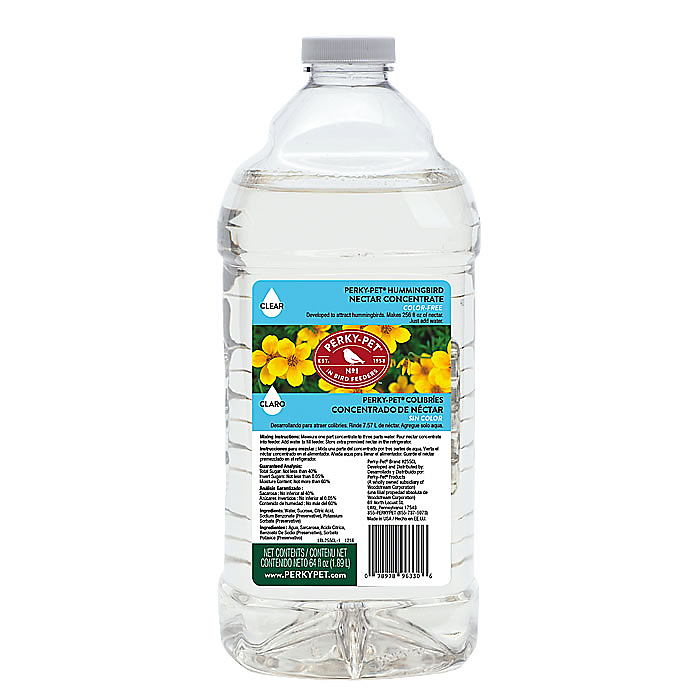 How to Mix Hummingbird Nectar Liquid Concentrate
How to Mix Hummingbird Nectar Liquid Concentrate
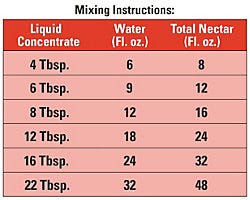
Perky-Pet® Clear Hummingbird Nectar Concentrate 64 oz Bottle
Our clear nectar keeps your backyard hummingbirds fueled and happy. Each 64 oz bottle of concentrate makes up to 256 oz of hummingbird food. This 100% sucrose concentrate mimics natural flower nectar and is the perfect energy source for every type of hummingbird.
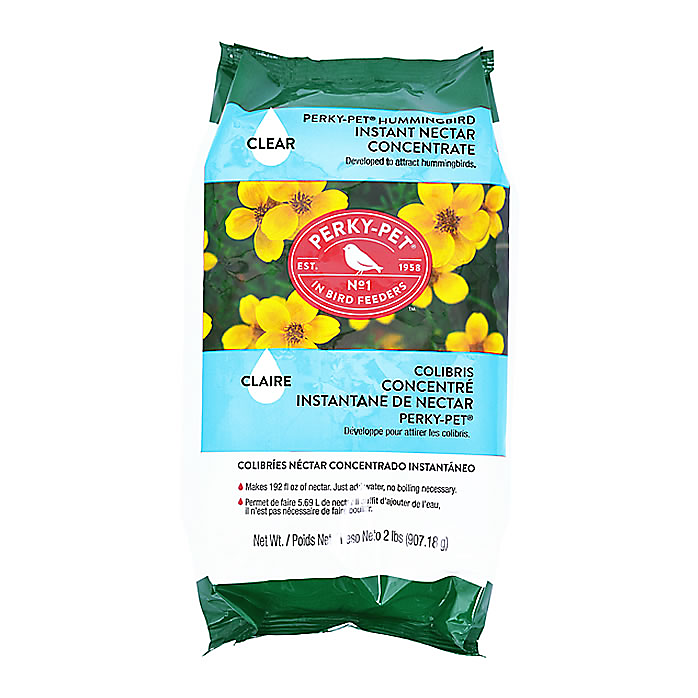 How to Mix Hummingbird Nectar Powder Concentrate
How to Mix Hummingbird Nectar Powder Concentrate
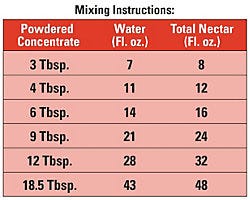
Perky-Pet® Instant Clear Hummingbird Nectar
Featuring a 100% sucrose formula, this Perky-Pet® Instant Clear Hummingbird Nectar provides the highest amount of energy to hummingbirds. The 2 lb bag makes up to 192 ounces of clear hummingbird nectar, so you’re sure to have enough to keep your hummingbirds coming back for more.
This hummingbird nectar concentrate is easy to mix: Simply stir in water and it’s ready to use.
How Often to Change Hummingbird Nectar and Clean your Feeder
Hummingbird food can spoil or ferment, which means hummingbirds will try it once or twice, but then it goes bad and they may never come back.
You must change your feeder’s nectar, even if it looks like it hasn’t lost a drop, on a regular basis. During hot weather, change it every two days. In milder weather, once a week is fine.
To further protect your hummingbird nectar from going bad, you’ll want to put your feeder in a place that gets a mix of sun and shade throughout the day. If the sun is too intense, the nectar can heat up and spoil or ferment in just a few hours.
That being said, keeping a feeder completely in the shade isn’t ideal either. When you do that, it will be harder for you to see your visitors’ iridescent colors.
If the feeder is cloudy or if you see black residue – clean immediately and clean very well. Rinse multiple times and let the feeder dry completely before refilling again. The existence of mold in a hummingbird feeder can be very dangerous for the hummingbirds who consume its nectar.
Hummingbirds live in many different parts of the world. They know the weather conditions and patterns just as well as you do (if not better!) and it’s important to help keep them comfortable in the given environment.
Here is a quick reference guide to use when dealing with different climates:
Very hot days = Clean & refill more often. Fill feeder only half full to reduce waste; consider moving to a shaded area until the weather cools slightly.
How to Clean Hummingbird Feeders
The very nature of hummingbird nectar makes it vital to keep your feeder clean. Since the nectar is a mix of water and sugar, it’s easy for micro-organisms to infest and spoil it. Once that happens, you definitely need to change your hummingbird food -- but you also need to clean your feeder, too! Doing so ensures that your feeders aren’t just transferring those micro-organisms to the next batch of nectar.
If the mold, bacteria and these other organisms build up too much, they can make your hummingbird visitors sick, and your birds can die by ingesting this bad nectar.
Hummingbird Feeder Cleaning Supplies
There are only a few supplies you’ll need to help you clean your hummingbird feeders. They are:
-
Bottle Brush -- A Foam Feeder Cleaning Mop, like the Perky-Pet® Feeder Cleaning Mop, is a small bottle brush with a sponge head and flexible neck. It will help you scrub the hard-to-reach portions of our hummingbird feeders.
-
Pipe Cleaners – Below, you will see we’ve suggested using pipe cleaners for scrubbing out the hard-to-clean inside of feeder holes. Don't use the multi-colored pipe cleaners available for craft projects. Instead, you want the type of pipe cleaner designed to clean actual tobacco pipes! These inexpensive tools are very similar to the craft items except they use a material that is better for scrubbing tight spaces.
-
Bucket/Sink – To help you rinse your hummingbird feeder properly, you’ll want a bucket or sink full of water.
-
Warm, Soapy Water – The best cleaning agent around! Warm, soapy water is often all you need to eliminate the micro-organisms that can build up in a hummingbird feeder.
-
Non-abrasive cloth – To help you with some additional scrubbing and to dry parts, a non-abrasive cloth is a great assistant.
Read more about how to clean a hummingbird feeder here.
Feeder Cleaning Tips
Luckily, the best hummingbird feeders are manufactured to be easy to clean! Perky-Pet® has a variety of hummingbird feeder styles, and each has parts that need to be cleaned slightly differently. Follow this guide while you clean each part of your hummingbird feeder:
-
How to Clean a Hummingbird Feeder Bottle – Although Perky-Pet® hummingbird feeder bottles come in a huge variety of shapes, they all can be cleaned the same way. Start out by rinsing the bottle out and then fill it with warm, soapy water. Empty that and then use the bottle brush to scrub the interior. Once clean, rinse and refill it with fresh nectar. Don’t forget to wipe down the outside of the bottle, too!
-
How to Clean a Hummingbird Feeder Base – The base of every Perky-Pet® hummingbird feeder can be popped apart with a gentle pull. Once you’ve done that, use your bottle brush to scrub the interior and all the nooks and crannies with warm, soapy water. Also scrub any perches and exterior surfaces. Some Top Fill Hummingbird Feeders have an extra O-ring washer inside the lower portion of the base. You should remove that for cleaning too. Just remember to install it in the same direction – if it goes back incorrectly, you won’t be able to reseal the base cover.
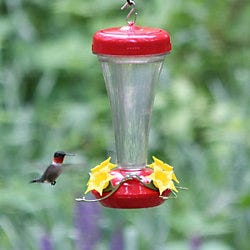
-
How to Clean Bee Guards – The yellow Bee Guards found on many feeders can be quite tricky to clean because of their small surfaces and corners. First, remove the guards and let them soak in warm soapy water for a few minutes. From there, pop them open and scrub them inside and out with a bottle brush. Once you’re done, snap them closed and re-install.
-
How to Clean Red Flower Petals – The large, red flower petals on many feeders simply slide off their feeder ports. Clean these by scrubbing them with warm, soapy water. The tube-like feeder ports they sit upon can be cleaned with a pipe cleaner.
-
How to Clean Decorative Flower Petals – These simulated flowers are usually white or another non-red color. Remove the base from the bottle and open the base up. Pop the entire flower off by pushing the plug from inside out, and then pull the plug from the flower petal base. To clean these parts, soak them in warm, soapy water and scrub each piece with a bottle brush. To scrub the inside of the plug, run a pipe cleaner through it a few times.
-
How to Clean Metal Flower Petals – These flower petals are usually permanently attached to the top of their base. Clean these just as you would a base – scrubbing with warm, soapy water over every surface. To make sure the actual feeder port is clean, scrub with a pipe cleaner.
-
How to Clean Button Flower Petals – These built-in Bee Guards are set flush against the feeder base and are usually white or yellow. To clean, first remove the bottle from the base and then open the base. Flip the top of the base over and squeeze the tabs while pushing the petals out. Once they are removed, clean them with warm, soapy water and use a pipe cleaner to scrub the inside passageway of the petal.
-
How to Clean a Hummerbar® -- Since it’s constructed unlike any other hummingbird feeder, the Hummerbar® needs its own set of instructions! Start by spraying it inside and out with a hose. Next, remove each of the petals and clean them by soaking and scrubbing them. Run a pipe cleaner through their holes to clean their interiors. The petals remove easily, just get a grip on them (with pliers, if necessary) and pull! Finally, dampen a washcloth in warm, soapy water and run it through the inside of the Hummerbar®, using a dowel rod can help you push it. Rinse and allow it to drip dry before adding nectar again.
Nectar Shelf Life and Expiration
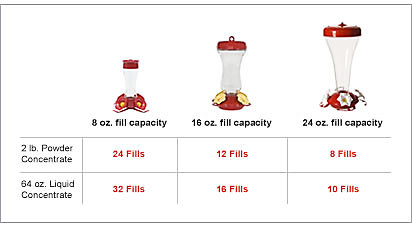
Our nectar does not have an expiration date, but we recommend that you store the nectar in a cool location.
How many times can I fill my feeders with the ready-made bottles of store bought hummingbird nectar?
Here is a helpful chart to help determine how much nectar you need:
Throughout the early Spring in most of the US, temperatures hover between the 60’s and 70’s. At these temperatures, you should be replacing your Hummingbird nectar every 5 to 7 days. Use the chart below to help calculate how much nectar you need as Hummingbirds begin their migration north!
Why 100% Sucrose? Sucrose vs. Dextrose and Fructose:
Hummingbird nectars mixed with Sucrose deliver energy quicker to hummingbirds because sucrose is digested faster by the birds. Dextrose and fructose, which are often used by other companies in their hummingbird nectar, fail to mimic the key properties of the natural flower nectar that serves as fuel for hummingbirds. Quite simply, nectars based on dextrose and fructose will not convert to energy as efficiently as Perky-Pet’s 100% sucrose formula.
Nectar Color FAQs:
Q: Why buy dye-free hummingbird nectar?
A: Perky-Pet® offers feeders that carry an array of proven attractants for hummingbirds, so it’s up to you to choose the nectar for your feeders. Clear hummer nectar is a clear alternative that does not have any artificial coloring or dyes. We asked ourselves, “Why not provide a clear food source for hummers?” That’s just what we did!
Q: Aren't hummingbirds attracted to red colored nectar?
A: No. When you watch hummingbirds in the wild, you see them visit plenty of non-red flowers. That being said, humans have trained hummingbirds to associate the color with food. That training is why most Perky-Pet® hummingbird products have red in them. Don’t worry if your feeder doesn’t have red in it, the hummingbirds are sure to enjoy it just as much.
Perkypet.com is the top destination to find quality Wild Bird Feeders and Accessories. Perky-Pet® and K-Feeders wild bird products are trusted brands to bird lovers everywhere. Interact with nature, relax and build memories that last a lifetime by conveniently ordering from perkypet.com. Happy Bird Feeding!





